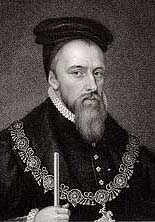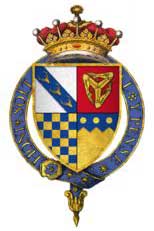


Thomas Stanley, 1st Earl of Derby, KG (1435 – 29 July 1504) was titular King of Mann, an English nobleman and stepfather to King Henry VII of England. The eldest son of Thomas Stanley, 1st Baron Stanley and Joan Goushill. Through his mother he was a lineal descendant of King Edward I by Elizabeth of Rhuddlan, Countess of Hereford and by the FitzAlan family, Stanley was a descendant of King Henry III.
A landed magnate of immense power, particularly across the northwest of England where his authority went almost unchallenged, even by the Crown, Stanley managed to remain in favour with successive kings throughout the Wars of the Roses until his death in 1504. His estates included what is now Tatton Park in Cheshire, Lathom House in Lancashire, and Derby House in the City of London, now the site of the College of Arms.
Although the king for the early part of his career, Henry VI, was head of the House of Lancaster, Stanley’s marriage to Eleanor, daughter of Richard Neville, 5th Earl of Salisbury (a descendant of Edward III) and sister of Richard Neville, Earl of Warwick (‘Warwick the Kingmaker’) in the late 1450s constituted a powerful alliance with the House of York. This did him no harm, however, even after Warwick was toppled from power, and in 1472, with the House of York now occupying the English throne, he married his second wife Lady Margaret Beaufort, whose son, Henry Tudor, was the leading Lancastrian claimant. He was the last to use the style ‘King of Mann’, his successors opting for the safer ‘Lord of Mann’. Stanley was “a man of considerable acumen, and probably the most successful power-broker of his age”
After the death of his father in 1459,Stanley inherited his father's titles, including those of Baron Stanley and King of Mann as well as his extensive lands and offices in Cheshire and Lancashire. It was a formidable inheritance and gave him ample opportunity to gain experience in the leadership of men. At the same time, his father's prominence in the king's household had provided him with an early introduction to court where he was named among the squires of Henry VI in 1454. Nevertheless, in the febrile and bloodthirsty circumstances of the Wars of the Roses it was a position fraught with danger as rival claimants for the throne – successively the Houses of Lancaster and York – demanded, threatened or begged for the support of Stanley and his followers.
The Stanleys had been among the earliest supporters of Henry Bolingbroke’s bid to win the English throne for the House of Lancaster in 1399 and Stanley’s great-grandfather Sir John Stanley, had been richly rewarded for his assistance. After some years of weak and ineffectual government led by the Lancastrian Henry VI, a challenge from the House of York broke out into open warfare in the 1450s in the War of the Roses. In 1459 an accord between the Lancastrian and the Yorkist lords broke down, and the conflict lapped at the borders of the Stanleys’ sphere of influence. With the Earl of Salisbury (Stanley’s father-in-law) mobilising on behalf of the House of York, Queen.